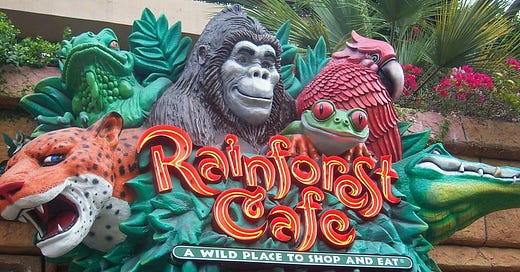My lovelies! There is now Smart Mouth merch. I picked some items that are very 2020s-appropriate, but also good anytime if you’re outdoorsy and/or eat lunch at the office. Click here to check it out.
I’m also putting on my business pants and launching a paid-subscriber-only monthly edition of the newsletter. It’ll be more informal, have more interviews, and maybe be a little gossipy. If you’re already paying the $5/month, you are already signed up. (And thank you.) If not, consider doing so now! It’ll be fun!
Photo: Loren Javier/Flickr
In the Jungle, the Capitalist Jungle
By Sarah Souli
The bio on the Rainforest Cafe’s Instagram is beguiling: “With 18 locations, this is as WILD as it gets!” There is no mention of an unending pandemic, epic wildfires, racial injustice, a hair-pulling election, or an attempted insurrection. In other words: The Rainforest Cafe has done the impossible. It has resoundingly ignored 2020 and just chugged on, churning out dinosaur-shaped chicken nuggets and volcano-inspired ice cream sundaes.
The first Rainforest Cafe opened in 1994 at the Mall of America; by 1999, there were dozens of locations stretching from coast to coast, and internationally. Each Rainforest Cafe was making at least $8 million per year, the highest revenue per location of any restaurant chain in the country. As a suburban child in the 1990s, there was truly no place more exciting to me than the Rainforest Cafe, and my perplexed immigrant parents gave in once a year on my birthday. It was normal to wait two to three hours for a table where the food could generously be described as microwaved flavor with a texture.
Photo: Leandro Neumann Ciuffo/Flickr
Food, though, is hardly the point. The Rainforest Cafe bills itself as a "safari for the senses" where you can "travel to the jungle" without driving further than your local mall. It is a restaurant staunchly committed to its globalized theme: Animatronic gorillas and leopards, waterfalls, dense layers of foliage, vines hanging from the ceiling. The soundtrack was always animalistic, too, all growling, squawking, and roaring. What I remember most about the Rainforest Cafe is the smell - not of the food, but a thick, plastic-y humid smell from the constant mist of programmed thunderstorms. Everything was so obviously fake, which was precisely the point.
Despite, or probably because of, its meteoric rise, the Rainforest Cafe fell just as quickly. Sales have dwindled and locations have shuttered, some within just a year of opening. There are still 18 locations across the U.S. and five internationally. There have been some attempts to keep up with the times - they’ve updated their menu to include a poke bowl - but it remains endearingly stuck in the consumerist time capsule of a large 1990s mall. And in that world, it’s true - the Rainforest Cafe was as WILD as it got. 🌿
(The Rainforest Cafe did not respond to a request for comment.)
Image: Andy Gorzalski via WUWM
Dinner and a Dolphin Show
Imagine going out to dinner to a posh Midwestern supper club, enjoying a porterhouse steak while dolphins leap out of water beside you, a nosy macaw circling, even following you into a bathroom stall. This was the experience for diners at Milwaukee’s Public Natatorium that operated from 1979 to 1985. I first learned about the restaurant while working on my new book, “Classic Restaurants of Milwaukee,” and knew I had to dive in deeper.
The building was practically made for the restaurant: it was built in the 1880s as an indoor public pool where Milwaukeeans could go to bathe and shower at a time when most homes didn’t have indoor plumbing. The pool managed to stay open until 1977, at which time local restaurateur John Garlic and his wife Margaret decided to turn it into a tropical, watery escape for the dinner crowd.
The Public Natatorium opened in 1979 to rave reviews. Diners sat at one of the tables surrounding the now-saltwater pool, or at a table up on the balcony that overlooked the water, and enjoyed five dolphin shows every night. By 1981, the Garlics practically had their own zoo: four dolphins, a plethora of exotic birds (including that macaw), and some sea lions. Families could participate in the shows, too, by feeding the dolphins and getting birthday kisses from them.
The success was short-lived, though. In 1985, the restaurant came crashing down under the weight of an enormous amount of debt. The Garlics were basically hemorrhaging money into the venture. After they paid $4,000 for the building itself, they then had to pay $50,000 to enclose the pool in glass. It cost $60,000 per year to rent the dolphins and their trainer from the Gulfarium in Florida; they spent $18,000 just on flowers; and their expensive taste filtered down to even the glasses, which cost $28 a cup. Add to that the expense of maintaining the pool and the animals’ health, staff costs, and customer food costs, and it’s not hard to see why bankruptcy was inevitable.
When the city finally boarded up the doors, the Garlics weren’t just broke, they were also in court answering for some animal abuse allegations made on behalf of the dolphins. The menagerie—at that point just Soda and two sea lions—was sent to an amusement park in California. Let that be a lesson. 🐬
More Food Reading
Some farmers in Georgia are fully aware of and believe in climate change. They’re switching out their crops accordingly. (This story is much better than it has any right to be!
This newsletter is edited by Katherine Spiers, host of the podcast Smart Mouth.
A TableCakes Production.
Want to contribute? Here are the submission guidelines.







LOVED both of these. I haven't thought about the Rainforest Cafe in like 20 years and I'd never heard of that dolphin restaurant in Milwaukee. So interesting!